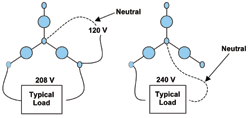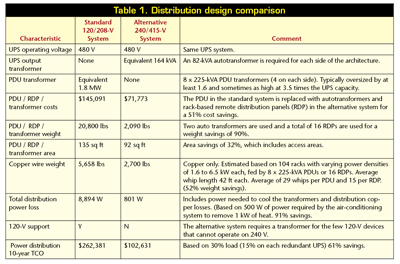Boosting data center system energy efficiency
Raising the power distribution voltage can yield significant energy and cost savings
BY DENNIS BOULEY
APC by Schneider Electric
West Kingston, RI
http://www.apc.com
Most modern information technology equipment is designed for world-wide compatibility. These systems can operate on the North American 120/208-V system, the Japanese 100/200-V system, and the 230-V system used in the rest of the world. If the power distribution system used in the rest of the world is applied to North American data centers, the result would be improved efficiency, reduced cost, reduced floor weight, floor space savings, and simplified power cabling.
High-density data center servers, where racks can draw from 10 to 40 kW each, place significant strains on the standard North American power distribution system. Increased rack power density results in the need for multiple branch circuits per rack, requiring additional breakers and cabling. The larger required power distribution units (PDUs) can consume up to 30% of the data center floor space and can represent 30% of the floor weight loading. With more PDUs installed per IT rack, capital costs increase.

The difference between three-phase 208- and 240-V distribution layouts.
Many countries around the world use 230-Vac line to neutral. Increasing the voltage to 240-Vac line to neutral will result in data center efficiency gains.
Why convert to 240 V?
Servers in data centers that draw their power from the 208-V high-voltage (line-to-line) connection in North America draw their power from the 230-V low-voltage (line-to-neutral) connection in almost every other country in the world. It is important to recognize that when comparing the “line to neutral” voltages of both distribution methods, the comparison should be between 120 and 240 V and not between 208 and 240 V. This “line to line” and “line to neutral” difference becomes readily apparent when the power capacity for a for a three-phase branch circuit is calculated.
For example, assume 20-A circuits are provided to the load in both cases. The power capacity for the 120-V “line to neutral” distribution method is calculated as 20 A x 120 V x 3 = 7.2 kW, while the capacity for the 240-V “line-to-neutral” distribution method is twice that or 14.4 kW, increasing the power density capability per rack without adding extra circuit breakers as would be the case with the 120/208-V distribution. The additional breakers would also be potential failure points.
Consider the same comparison, except assume 10 kW is available to the load in either case. The higher 240-V distribution yields the same power capacity with nearly half the current. This means the branch circuit wires in the traditional North American system have to be 300% larger.
Eliminating PDU transformer
Even more important than the cost, size, and weight savings in wiring is the savings in transformers. The PDU transformers required in North America to convert the voltage from the UPS output of 277/480 down to the 120/208 V can be eliminated.
In the rest of the world, the UPS output of 230 V/400 V can be used without an additional transformer. Similarly, the proposed power distribution approach eliminates distribution transformers and supplies the IT loads with 240 V.
An additional transformer is used to change the UPS output voltage from 277/480 V to 240/415 V in the proposed new method. While it appears that this transformer simply replaces the PDU transformers, in fact it is 90% smaller and less expensive than the PDU transformers.
The reason for this is the new unit is wired as an autotransformer, which has only one winding, as opposed to two in an isolation transformer (primary and secondary), and is therefore less than 20% of the size and weight of a standard transformer of the rated UPS capacity.

Also, it is sized to the UPS capacity, in contrast to the PDU transformers which, as a group, are typically sized at 1.5 to 3 times the UPS capacity. Table 1 provides a comparison.
A comparison of conventional power distribution design with the alternative design was performed based on an actual data center. The data center is 2,175 ft2 and consists of two redundant modular 600-kW UPSs. A total of 104 racks range in density from 1.6 to 6.5 kW each.
This proposed data center 240/415-V distribution system demonstrates a total cost-of-ownership savings of 61% and a space savings of 32%. Of the TCO cost savings, approximately 47% is due to material and 53% energy savings. In addition, the proposed alternative design can operate alongside conventional power distribution designs in existing data centers.
For more information on efficient power conversion, visit http://www2.electronicproducts.com/power.aspx and http://www2.electronicproducts.com/energy.aspx ■
Advertisement
Learn more about APC by Schneider Electric





